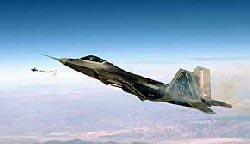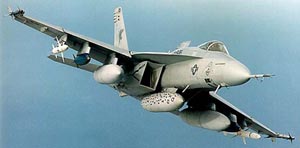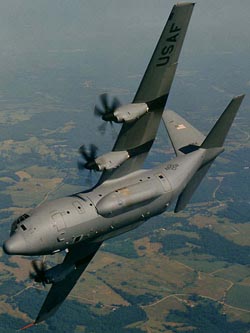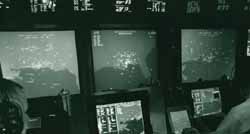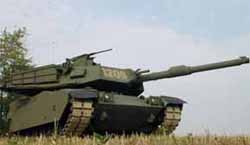Page 1
Daily News
By Gail Helmer
| Send Us News | Archives | Main |
Wednesday September 26, 2001
- Open Letter to WWII Online Community
- New Battlefield 1942 Screens
- AMD Makes Job Cuts
- Reserve Units Called To Active Duty
- Boeing Delivers First Full-Rate Production Super Hornet
- New Software For C-130U Avionics System
- Raytheon's CEC Passes US Navy OPEVAL
- General Dynamics To Unveil 120s MBT At IDEF 2001
- Commander Explains USAFE's Role In Future Operations
- Mystique Surrounds U.S. Special Operations Units
PC News
Open Letter to WWII Online Community
Date: 09/25/01 03:45:00
OPEN LETTER TO: All WWII Online community members
FROM: Jim Mesteller, President and CEO of Playnet, Inc.
We really appreciate all the gamers who have already purchased and continue to buy WWIIOL. Thank you very much. You now number in the tens of thousands. We are hopeful that thousands more will begin joining your ranks by year’s end as our publishing and distribution partners release the Macintosh version and then perhaps several foreign language-localized versions of ‘Blitzkrieg’ to international markets. But right now, YOU are our number one priority.
We continue to concentrate our efforts on making your overall gaming experience in WWIIOL better... on making the gameplay better, on making the service better, and simply getting on with all that we’ve had planned for Playnet.com, ‘Blitzkrieg’, and the rest of the WWIIOL design.
It is important to remember that with ‘Blitzkrieg’ we are just getting started. What we have now implemented in both gameplay features and support services is just the beginning of the WWIIOL campaign. We’ve got much more planned. Currently we are dedicated to quality and performance first. Of course we will bring you more ‘stuff’ as we can. We’re trying to get out another upgrade or two for WWIIOL before Playnet.com actually starts ‘pay-to-play’ service. Another significant upgrade should follow soon after ‘pay-to-play.’ I believe that we have made significant progress in improving all aspects of WWIIOL gameplay and support services, and we will continue to make marked improvements as part of our regular development process.
Everyone here at Playnet strives to make WWIIOL something very special... more than just a game... more than just a sim. As MMOGs like WWIIOL go... they are as much about ‘community’ as gameplay. That is a big part of why MMOGs can be so compelling, so immersive, so addictive.
We think the experience of WWIIOL is already something special. We’re trying to give each player unprecedented control over what their gameplay can be all about. We have no scripts. No one is forced into pre-programmed scenarios. As the development effort by CRS expands for ‘Blitzkrieg’ and beyond, Playnet will continue to make available not only more advanced gameplay features, but also web-based tools and services that will allow you to maximize the enjoyment of your WWIIOL membership, both inside the game and on the web sites of the Playnet.com network.
This business, particularly the massively multi-player online games market, is very competitive. We realize that we are competing for your time and your money. We realize that your expressed satisfaction will ultimately measure the level of our success or failure as a business. It’s our goal to do all that we possibly can to deliver an enjoyable and unique gaming experience, and to provide support to the levels of satisfaction that all of us here would expect, if we were the customers.
Please remember that some of the most avid and experienced gamers you’ll ever meet are employed at Playnet/CRS, and they all want the same things as you. Actually, they want even more.
We thank you for your cooperation and support during our launch period. We are very eager and determined to move this project along. We chose Playnet.com and WWIIOL as projects knowing what the challenges and risks were. Certainly other projects were available that we could have built a business around…projects that weren’t as challenging, and weren’t as risky. But we all believe in what we are doing. We believe that with your continued help and support we can and will make both Playnet.com and WWIIOL successful.
We really hope to convince YOU ALL to stay with us…to spend a little of your money and a lot of your time... and enjoy Playnet.com and WWIIOL for many years to come. I hope that you’ll choose to do just that, because we’re all in this together. We’re all part of the WWIIOL community.
Thanks very much.
Jim Mesteller
President and CEO Playnet, Inc.
New Battlefield 1942 Screens
EA has sent us the latest screenshots from Digital Illusions upcoming title Battlefield 1942. Set in WWII players can storm the beaches of Normandy, direct artillery at Kursk, pilot a fighter at Midway, shell an airstrip at Gaudalcanal, and command a tank in Tobruk. Battlefield 1942 is multiplayer-focused with support for up to 64 players, there will be a mode for single player action. Playing as an infantry officer, gamers will be able to operate many weapons of war available to the Axis and Allies as well as command numerous land vehicles, ships and aircraft. With larger craft such as a bomber or battleship, the game will allow players to choose what stations they will serve - pilot, gunner, captain, bombardier, etc. Originally slated to appear in stores in September, the game is now scheduled to debut in Spring 2002. Previous Coverage
AMD Makes Job Cuts
AMD today announced it is accelerating key components of its strategy to reduce costs and enhance the financial performance of its core businesses. The company will close Fabs 14 and 15, two semiconductor wafer fabrication facilities (fabs) in Austin, Texas that primarily serve AMD's foundry operations. AMD will also reduce and restructure other manufacturing activities as well as administrative support associated with these facilities.
These changes will result in the reduction of approximately 2,300 positions, or approximately 15 percent of its worldwide workforce, by the end of the second quarter of 2002. Approximately 1,000 of these positions are associated with closing the fabs in Austin. The balance of the reductions will result from realigning and restructuring back-end activities in Penang, Malaysia. The company will provide severance packages and outplacement services to affected employees.
Military News
Reserve Units Called To Active Duty
Approximately 826 Army National Guard, Army Reserve, Air National Guard and Air Force Reserve members are being called to active duty as part of the partial mobilization authorized by President Bush.
These soldiers and airmen called to active duty in this announcement serve in 17 different units from 10 states and the territory of Puerto Rico. Among the specialties represented in these units are communications, intelligence, security, mortuary affairs and military police support.
In addition, the Naval Reserve Force has called to active duty approximately 835 Naval reservists across the United States who will serve in security and law enforcement capacities. This brings the total National Guard and Reserve called to active duty to about 14,000 to date.
Boeing Avionics Guide F-22 Missile To Target
The F-22 program achieved a major milestone Sept. 21 when Raptor 4005 fired an AIM-120C Advanced Medium-Range Air-to-Air Missile, or AMRAAM, for the first time against a drone at Point Mugu Naval Test Range, Calif. The missile was guided by avionics software integrated by Boeing.
The AMRAAM closed to within optimum range of the target seconds after launch high over the Pacific test range. The guided missile launch demonstrated the F-22's ability to detect and track a long-range target. This is the fourth significant avionics milestone to be accomplished this year as the F-22 weapon system builds up to an initial operational test by the U.S. Air Force in 2003.
The aircraft used the Block 3.0 avionics software developed and tested by Boeing. The advanced software incorporates avionics integration including sensor fusion. Sensor fusion occurs when targeting, detection and tracking information is fused from multiple sensors to create a single input to the pilot.
"The key to the successful missile shot is the unprecedented level of avionics and weapons integration by Boeing workers here in Seattle and at other F-22 sites," said Henry Brandis, a lead weapon system engineer at Boeing.
Boeing has been testing avionics software packages in its Avionics Integration Lab since 1998, on its 757 Flying Test Bed since March 1999, and on the F-22 Raptor flight test aircraft since January 2001.
The missile shot comes a month after the Defense Acquisition Board approved production of 10 F-22 aircraft, allowing the program to enter low-rate initial production. Boeing is teamed with Lockheed Martin, Pratt & Whitney and the U.S. Air Force to develop the F-22. Boeing supplies the F-22's wings, aft fuselage, avionics systems, training and life-support systems. A Northrop Grumman-led joint venture with Raytheon, under contract to Boeing, is developing, testing and manufacturing the radar system for the F-22.
Boeing Delivers First Full-Rate Production Super Hornet
The U.S. Navy Friday accepted its first full-rate production F/A-18E/F Super Hornet from The Boeing Company. The two-seat F model Super Hornet is bound for Naval Air Station Patuxent River, Md. "Delivery of this Super Hornet further demonstrates the dedication and commitment of the Hornet Industry Team," said Tony Parasida, Boeing F/A-18 vice president. "Our team is not satisfied with performing as expected. Our goal is to perform better than expected, and we've done that by delivering this first multiyear procurement Super Hornet ahead of schedule."
Delivery of this aircraft represents yet another milestone in the Super Hornet program the delivery of the first Super Hornet equipped with the Joint Helmet-Mounted Cueing System, or JHMCS. JHMCS technology allows airplane crews to aim weapons and sensors by looking at targets. The system also enables users to t rack and attack targets more quickly, greatly increasing combat effectiveness.
To date 63 Super Hornets have been delivered to the U.S. Navy, including 34 to Training Squadron 122 (VFA-122) and 12 to Strike Fighter Squadron 115 (VFA-115), the first operational Super Hornet squadron.
Built by the industry team of Boeing, Northrop Grumman, GE Aircraft Engines, Raytheon and 2,000 other suppliers, the Super Hornet embodies the newest advances in multimission capability and offers decades of growth potential.
New Software For C-130U Avionics System
Lockheed Martin has begun the delivery of C-130J aircraft with a new software configuration that brings the aircraft's avionics system to full functionality. Known as Block 5.3, the new software incorporates substantial upgrades and new capabilities and is now the baseline for all production C-130J aircraft.
The KC-130J tankers now being delivered to the US Marine Corps all have Block 5.3, and the Royal Australian Air Force is the first operator to accept 5.3 for its existing aircraft. The company has completed all necessary testing to prove the airworthiness of the new software and its operation with aircraft hardware.
Block 5.3 gives crews the ability to fly integrated precision radar approaches. It also provides enhanced navigation capabilities as well as fully automatic formation flying. The software allows both new C-130Js and older C-130s to fly in formation using the Coordinated Aircraft Positioning System. Now a mixed fleet of C-130 transports can stay in formation while the autopilot and auto-throttle systems on the C-130Js are engaged. Block 5.3 also addresses nearly all of the operational items the US Air Force raised during development and operational testing.
The new software will be installed in the deployed world-wide fleet of C-130J and the longer fuselage length C-130J-30 aircraft over a period of about a year, beginning in the next few weeks.
"No military transport aircraft in production today has a mission software package as advanced and sophisticated as that on the J. It truly represents the very leading edge of systems technology,'' said C-130J programme vice president Ross Reynolds.
Current customers for the C-130J and C-130J-30 include the US Air National Guard and Air Force Reserve Command, US Coast Guard, US Marine Corps, U.K. Royal Air Force, Royal Australian Air Force, Italian Air Force, and the Royal Danish Air Force.
Raytheon's CEC Passes US Navy OPEVAL
The US Navy's Cooperative Engagement Capability (CEC), produced by Raytheon, passed its recent Operational Evaluation (OPEVAL) Test- clearing the way for a Department of Defense (DoD) full-scale production (Milestone III) decision in the fall.
With a go-ahead from DoD, the Navy can start the process of building approximately 160 systems in full-rate production quantities. Raytheon is currently producing more than 50 CEC systems under low-rate initial production contracts.
Developed by Raytheon and Johns Hopkins University's Applied Physics Laboratory for the Navy, CEC is a unique sensor networking system that integrates radar measurements in real time. To help the fleet defend against advanced threats such as cruise missiles, CEC generates a composite track for each air-space object. CEC's tracks are so accurate that they let warfighters find and destroy advanced threats at ranges not previously possible.
The system's operational evaluation occurred in May and June of 2001, during a three-week testing cycle conducted along the Atlantic coast and in the Caribbean. Sailors aboard six CEC-equipped ships and one CEC-equipped E- 2C aircraft conducted the OPEVAL, with support from two non-CEC ships, fleet aircraft squadrons and multiple land-based test sites.
CEC's OPEVAL was one of the most complex evaluations ever conducted. It included multiple stressing scenarios and live missile firings. Combined with the testing performed during CEC's February 2001 technical evaluation, the system has been fully evaluated in wartime conditions that include multiple hostile threats, difficult tracking scenarios and extensive jamming.
CEC-equipped OPEVAL platforms included the USS John F Kennedy (CV-67), the USS Anzio (CG-68), USS Cape St. George (CG-71), USS Hue City (CG-66), USS Vicksburg (CG-69), USS Wasp (LHD-1) and the E-2C test aircraft A-125, plus East Coast test sites. Two ships that are not equipped with CEC, the USS Carney (DDG-64) and USS The Sullivans (DDG-68), supported the evaluation.
In June, Raytheon was awarded $63 million for the fourth phase of CEC's Low Rate Initial Production (LRIP).Six shipboard and one airborne system were covered in the contract. At the same time, Raytheon delivered the second LRIP II system.
General Dynamics To Unveil 120s MBT At IDEF 2001
General Dynamics will introduce its 120S MBT during the opening ceremonies at IDEF 2001, which begins in Ankara, Turkey on 27 September. The General Dynamics 120S is an upgrade of the M60 tank that integrates the M1A1 120-mm turret, equipped with a 240X4 Forward Looking Infrared Radar (FLIR), onto a fully modernised M60 chassis. The turret is protected with the latest armour, which was successfully demonstrated to the Turkish Main Battle Tank Committee. Additionally, the 120-mm ammunition is fully compartmentalised, providing optimum system survivability.
The 120S chassis includes an M1A1 suspension system, giving the tank greatly improved cross-country mobility and a stable base for fire-on-the-move accuracy similar to the Abrams tank.
The new 120S is fully functional, ready to accept a powerpack of the customer's choice. To achieve mobility similar to an M1A2 Abrams tank, a 1200-horsepower AVDS-1790 engine is recommended. However, other propulsion options are also possible.
"The 120S is an exciting product that offers a proven and affordable M60 upgrade solution to potential customers. The 120S makes existing M60 fleets relevant by increasing their capability to close to that of the M1A1 Abrams tank's performance, at half the price," said Henry Umanos, director of international business development and 120S programme director for General Dynamics Land Systems.
Commander Explains USAFE's Role In Future Operations
AVIANO AIR BASE, Germany (AFPN) -- The commander of U.S. Air Forces in Europe spoke about the Sept. 11 terrorist attacks in the United States, and explained USAFE's role in any retaliatory operations during a recent visit here.
Gen. Gregory S. Martin, who also commands NATO's Allied Air Forces Northern Europe, said Sept. 20 that he wants people to know exactly what the U.S. military is going up against and expects that everyone in USAFE will play a role as America's armed forces heed's President Bush's call to "be ready."
"It's important for everyone to understand that the enemy we are going against is a fairly large network of terrorists around the world," Martin said. "It is also important we realize the U.S. military, along with forces of the other countries aligning with us, will have a bigger network and all of us will play.
"We don't know which one of us will be the right sensor, or the right munitions loader or the right aircraft crew at the right time to make a difference," he said. "But each and every one of us will play in this network, which is turning into a fairly extensive global war."
As forces begin to move and position themselves for war, Martin said. He believes each person on the USAFE team will have a role to play and a contribution to make. "The men and women of USAFE will be supporting forces as they come through. In many cases, those people already assigned to an (air expeditionary force) bucket will be asked to deploy to different bases ... and support our expeditionary operations," Martin said.
Considering everybody is critical to the success of the mission, he said, "Protecting people is a top priority. "It is absolutely critical not to lose anyone," he said. "I think everyone can see it at the front gate and in our work areas; we're all taking force protection seriously." But having good situational awareness and exercising vigilant force protection is not just a job for military people, he said. "It requires a contribution from the entire Air Force family. "We have to realize that we are all sensors," he said. "You just don't know what vehicle may be harboring terrorists. We all have to have our antennas up, looking 360 degrees. It doesn't matter if you are a military member, a civilian or a family member, we all have to play in this effort."
Mystique Surrounds U.S. Special Operations Units
MIAMI (Reuters) - U.S. military special forces have fought across the globe from the jungles of Vietnam to the Iraqi desert, earning a reputation for their courage, fighting skills and self-reliance. With their blackened faces, secretive missions and high-tech weaponry, the mystique around them has fascinated movie-goers, armchair warriors and military buffs. That reputation could be tested again soon as the Special Operations forces, which include such units as the Green Berets, Rangers and Navy SEALS, are expected to play a vital role in U.S. efforts to hunt down the militants behind the Sept. 11 attacks on Washington and New York. [More...]
| Send Us News | Archives | Main |
